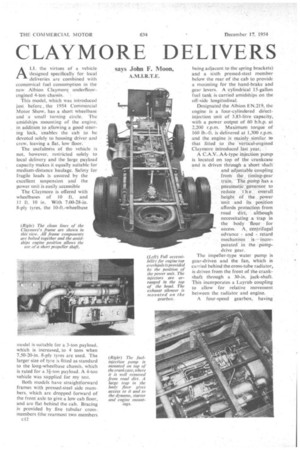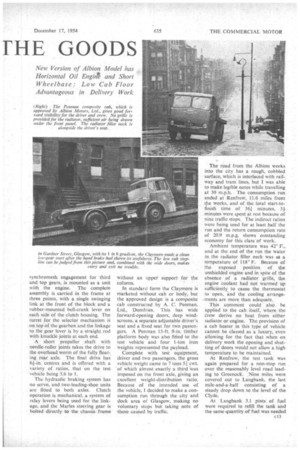CLAYMORE DELIVERS THE GOODS
Page 50

Page 51

Page 52

If you've noticed an error in this article please click here to report it so we can fix it.
says John F. Moon,
A.M.I.R.T.E. ALL the virtues of a vehicle 'designed specifically for local deliveries are combined with economical fuel consumption in the new Albion Claymore underfloorengined 4-ton chassis.
This model, which was introduced just before. the 1954 Commercial Motor Show, has a short wheelbase and a small turning circle. The amidships mounting of the engine,in addition to allowing a good steering lOCk, 'enables the cab to be devoted solely to housing driver and
crew, leaving a flat, low floor.
The usefulness of the vehicle is not, however, restricted solely to local delivery and the large payload capacity makes it equally suitable for medium-distance haulage. Safety for fragile loads is assured by the excellent suspension and the power unit is easily accessible The Claymore is offered with wheelbases of 10 ft. and 11 ft. 10 in. With 7.00-28-in. 8-ply tyres, the 10-ft.-wheelbase
model is suitable for a 3-ton payload, which is increase& to 4 tons when 7.50-20-in. 8-ply tyres are used. The larger size of tyre is fitted as standard to the long-wheelbase chassis, which is rated for a 3i-ton payload. A 4-ton vehicle was supplied for my test.
Both models have straightforward frames with pressed-steel side members, which are dropped forward of the front axle to give a low cab floor, and are fiat behind the cab. Bracing is provided by five tubular crossmembers (the-rearmost two members
c12
being adjacent to the spring brackets) and a sixth pressed-steel member below the rear of the cab to provide a mounting for the hand-brake and gear levers. A cylindrical 15-gallon fuel tank is carried amidships on the off-side longitudinal.
Designated the Albion EN.219, the engine is a four-cylindered difectinjection unit of 3.83-litre capacity, with a power output of 60 b.h.p. at 2,200 r.p.m. Maximum torque of 160 lb.-ft. is delivered at 1,300 r.p.m. and the .engine is mainly .similar na that fitted to the 'vertical-eagined Claymore, introduced last year.
A C.A.V.AA-type injection pump is located on top of the crankcaSe and is driven thfough a: short shaft • and adjustable coupling Irwin the • timing-gear . train. The pump has a . pneumatic governor to reduce t h e .. overall height of the . power unit . and its position
• affords protection from . road dirt, although necessitating a •trap in the body -floor • for access. A. centrifugal advance and retard . mechanism is-• incorporated in the pump. drive gear.
impeller-type water pump is gear-driven and the fan, which is carried behind the cross-tube radiator, is driven from the front of the crankshaft through a 30-in. jack-shaft. This incorporates a Layrub coupling to allow for relative movement between the radiator and engine.
A four-speed gearbox, having The synchromesh engagement for third and top gears, is mounted as a unit with the engine. The complete assembly is carried in the frame at three points, with a single swinging link at the front of the block and a . rubber-mounted bell-crank lever on each side of the clutch housing. The turret for the selector mechanism iS on top of the gearbox and the linkage to the gear lever is by a straight rod with knuckle joints at each end.
A short propeller . shaft with needle-roller joints takes the drive to the overhead worm of the fully floating rear axle. The final drive has 6i-in. centres and is offered with a variety of ratios, that on the test vehicle being 5.6 to I.
The hydraulic braking system has no servo, and two-leading-shoe units are fitted to both axles. Clutch operation is mechanical, a system of relay levers being used for the linkage, and the Mules steering gear is bolted directly to the chassis frame Without an upper support for the column.
In standard form the Claymore is marketed without cab or body, but the approved design is a composite cab constructed by A. C. Penman, Ltd., Dumfries. This has wide forward-opening doors, deep windscreens, a separate adjustable driver's seat and a fixed seat for two passengers. A Penman 13-ft. 9-in: timber platform body was also fitted to the test vehicle and four 1-ton iron weights represented the payload.
Complete with test equipment, driver and two passengers, the gross vehicle weight came to 7 tons 51 cwt. of which almost exactly a third was imposed on the front axle, giving an excellent weight-distribution ratio. Because of the intended use of the vehicle, I decided to make a consumption run through the city and dock area of Glasgow, making no voluntary stops but taking note of those caused by traffic. The road from the Albion works into the city, has a rough, cobbled surface, which is interlaced with railway and tram lines, but I was able to make legible notes while travelling at 30 m.p.h. The consumption run ended at Renfrew, 11.6 miles from the works, and of the total start-tofinish time of 361 minutes, 3i minutes were spent at rest because of nine traffic stops. The indirect ratios were being used for at least half the run and the return consumption rate of 20.9 m.p.g. shows outstanding economy for this class 'of work.
Atnbient temperature was 42° F., and at the end of the run the water in the radiator filler neck was at a temperature of 118° F. Because of the exposed position of the unshielded engine and in spite of the absence of a radiator grille, the engine coolant had not warmed up sutticientlx to cause the thermostat to open, and the cooling arrangements are more than adequate.
This comment could also be applied to the cab itself, where the Crew derive no heat from either radiator or engine. The provision of a cab heater in this type of vehicle cannot be classed as a luxury, even allowing for the fact that when on delivery work the opening and shutting of doors would not allow a high temperature to be maintained.
At Renfrew, the test tank was again prepared for a non-stop run over the reasonably level road leading to Greenock. Nine miles were covered out to Langbank, the last mile-and-a-half consisting of a steady drop down to the level of the Clyde.
At Langbank 3.1 pints of fuel were required to refill the tank and the same quantity of fuel was needed c13
at the end of the return run, despite the long pull up from the river. The consumption rate was thus 23.15 m.p.g. for an average speed of 27.25 m.p.h. Maximum speed during both runs was not allowed to exceed 35 m.p.h.
A second test was conducted along part of the same road, making two stops per mile. At each halt, the engine was allowed to idle for 15 sec. Eight miles were covered in a running time of 23 min. 25 sec. at the expense of 3.8 pints of fuel, giving a consumption rate of 16.8 m.p.g. for an average speed of 20.3 m.p.h. Thus, economy was above average for these conditions with a 4-ton payload.
A dry surface could not be found for the braking tests and because of the failing light, I had to conduct them on a rather greasy stretch of asphalted main road. From 20 m.p.h. the average stopping. distance was 22 ft., andsof this distance 12 ft. were covered with all wheels locked.
Similarly, from 30 m.p.h.. 51 ft. were required in which to bring the C14
Claymore to a halt, with the wheels locked for 27 ft. Because of the absence of a servo, with a 4-ton payload a heavy braking pressure was needed for an emergency stop, but for all normal braking purposes no undue pedal pressure was called for.
Acceleration figures revealed adequate engine power to give an average performance. This power was also evidenced, in a spirited ascent of the 1 in 6 average gradient of Gardner Street, Glasgow. This was made in tow gear at threequarters throttle opening. A stop on the hill showed the effectiveness of the haud brake and the first-gear start was smooth.
drove the chassis several times during the day and appreciated its good manceuvrability in traffic, coupled with the ample vision afforded by the forward position of the cab and the deep windscreen. The seat is high enough to enable the driver to see over the tops of parked cars when looking for a place to pull in when making a delivery:
It was possible to turn round without reversing on an average main road and the vehicle was light to handle when travelling normally. The gear change was generally good, although it was necessary to become accustomed to the long travel between low and second ratios.
There was hardly any engine noise in the cab, which, coupled with the lightness of the controls, should save the driver from fatigue.., The simple construction of the chassis and the easy accessibility of the power unit and other running components will appeal to the maintenance man. The traffic manager will like the roominess of the body. The long-wheelbase version, in particular, offers great possibilities for large vans carrying light, bulky commodities.
For operators who are looking for an economical vehicle, which will travel quickly between towns and is suitable for local deliveries at the end of the run; the ,Claymore is an excellent choice.












































































































